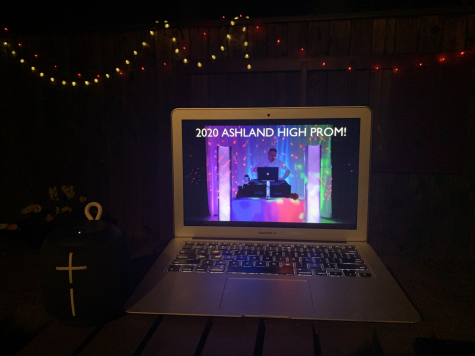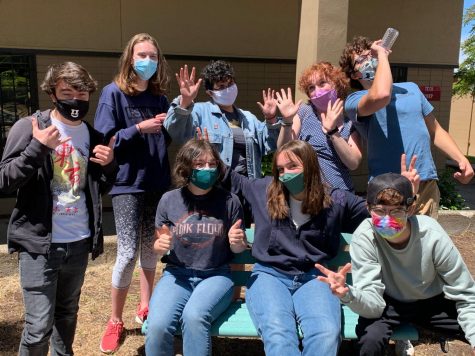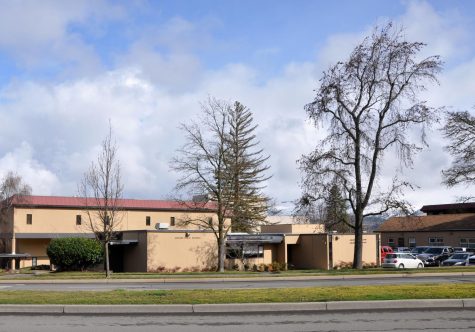Truth to Power Presents the BIPOC Celebration Mural
On August 4th, 2021, Isadora Millay messaged the Truth to Power club group chat: “Big day of celebration, guys — we got the mural passed! Both City Council and the Public Arts Commission gave a unanimous ‘yes’ to the mural.”
Lead artist Isa Martinez Moore, advisor Shane Abrams, and students Anya Moore, Isadora Millay, Mirandah Davis-Powell, and Zia Brandstetter – like many Ashland residents – were led to question Ashland’s progressive reputation by Aidan Ellison’s murder in 2020. These individuals constitute the “Mural Team,” formed in February of 2021 through AHS’ Truth to Power club. They saw Ashland High School’s gray wall facing South Mountain Avenue as an opportunity to galvanize conversation about race in Ashland’s predominantly white environment and honor noteworthy BIPOC figures with connections to the Rogue Valley, including Aidan. “We were all so happy and really eager to get started with the actual process,” said Martinez Moore in response to the city’s approval of the idea.
The mural’s artwork exudes a celebratory attitude and features eight BIPOC activists, writers, and other leaders tied to the Rogue Valley. Among them are Michelle Alexander, author of “The New Jim Crow,” Gina DuQuenne, co-founder of Southern Oregon Pride, and Agnes Baker Pilgrim (a.k.a. Grandma Aggie), co-founder of the International Council of 13 Indigenous Grandmothers. Swoops of color weave through the boxed portraits of the chosen eight individuals to the left of a large orange oval encompassing Ellison’s portrait. He is portrayed looking upward and shadowed by a lion, a reference to his mother’s characterization of him and his astrological sign of Leo.
Truth to Power club hosted a community painting day on September 26th that invited Ashland citizens to contribute to the mural-painting process. Children, parents, elders, and teachers dipped brushes into paint and added touches to the wall. The Mural Team was on a roll, steadily working toward their goal of completion by November. Then, on October 1st, they encountered a setback. “I’m sorry to be the bearer of bad news,” messaged Abrams to the team. “We got tagged.”
Ellison’s orange background and the beginnings of his lion-like silhouette were blanketed by a black layer of spray paint. Purple graffiti marred the colorful wall, leaving the Mural Team in disbelief. Martinez Moore described their shock: “From the very beginning, we talked a lot about how we should be prepared for there to be vandalism or for it to get tagged. But it was so shocking… I still thought nobody would want to do that.” Members of Truth to Power club and the Mural Team, along with a few volunteers, spent the afternoon scrubbing the graffiti with soap and water and reflecting. “It’s so disheartening,” stated Davis-Powell. Martinez Moore disclosed, “After I got the crying out, I just got really angry… I literally feel like I went through the stages of grief.”
It became clear, however, that this misfortune had the potential to strengthen the project. Truth to Power club proves to be a resilient group of people who refuse to tolerate injustice or surrender to criticism. “The reason we’re doing this mural and the message it sends is stronger than any vandalism,” said Millay. “We will persevere.” And persevere they did.
Truth to Power remains as active as ever, currently in the process of producing a live radio segment, upcoming podcasts and series, and community service projects. Most importantly, the mural itself is healing with the help of tremendous community support and the Mural Team’s diligent work. A public dedication ceremony celebrating its completion, featuring live performers, is planned for November 23rd, the anniversary of Ellison’s death.
The Truth to Power BIPOC Celebration Mural incentivizes bystanders to evaluate their roles in the fight for racial equality and cherish diversity and inclusion in our valley. It honors the beauty of the individuals portrayed and all they have accomplished. It serves as a constant reminder that anti-racist conversations, although difficult, are essential to the process of transforming Ashland into a place of acceptance toward BIPOC individuals. It commemorates Aidan Ellison while acknowledging the Rogue Valley’s racial detriments and shows that all of us must work thoughtfully and consistently to change our valley for the better.







